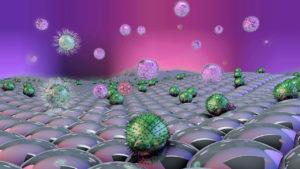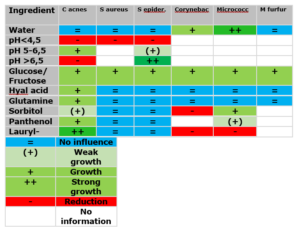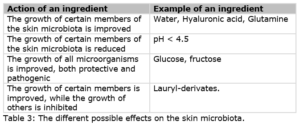 Photo from Giobiotics ingredients
Photo from Giobiotics ingredients
Originally Posted On: https://www.gobiotics-ingredients.com/articles/untold-story-microbiota/
The gentle power of the skin microbiota
One of the biggest concerns in the personal care is how to formulate for the sensitive skin. This is because the number of allergies and skin reactions in sensitive skin is significantly rising. Moreover, the consumer became extremely demanding and cannot accept any mistake from any cosmetic brand anymore.
Brands are nevertheless doing their best to respect the human skin. They use mild emulsifiers; safe preservatives and they are limiting perfume. But even then, they still can face some complaints from the consumer. In order to formulate bullet proof cosmetics, brands need to do extra efforts to go to the next level of skin mildness and enter the unexplored area which is the skin microbiota.
For the microorganisms the skin is their sole source of food. The skin provides them with:
- Dead skin cells (corneocytes)
- Sebum
- Oxidized lipids
- Sweat
For decades cosmetic products have been focused on the human part of the skin. It was assumed that the skin, our outermost organ, is in direct contact with the environment. The outermost layer was believed to be the horny layer. This insight recently needed to be improved, as the skin cells on their turn are protected by a mysterious and fascinating layer of micro-organisms: the skin microbiota. The skin microbiota is known as the microbial layer that is in contact with the fickle and hostile environment.
The skin and the skin microbiota are not separated layers. As a matter of fact, both layers work together and are intertwined. They thrive in a kind of successful marriage. Both layers need each other and help each other. Together they are one. They form one gigantic impregnable barrier against the environment and all its threats.
In return the skin microbiota gives a lot of benefits. Indeed, the food that the skin supplies is actually just the garbage of the skin, which is excreted and peeled off. However, by eating the skin waste, the skin microbiota actually cleans it away. Therefore, the skin microbiota keeps our skin clean.
But the skin microbiota’s activity goes far beyond cleaning, as it transforms the skin garbage into precious substances such as:
- Antimicrobial peptides protecting the skin from the invasion of pathogenic bacteria
- Organic acids avoiding the colonisation of voracious fungi
- Proteins regulating our inflammation process during UV exposure. Consequently, limiting sun damage
- 6-HAP which is an efficient anti-cancer purine, both avoiding and curing skin cancer
- SOD, which is an antioxidant that goes beyond the efficiency of vitamin E, as it avoids the formation of free radicals
- Glycerine/proteins providing a hydration.
It turns out that the skin microbiota is more than merely a collection of different microorganisms. It is also a precious mixture of vital substances forming together a life essential elixir for the skin. The most noble task of the skin microbiota is that it takes away a lot of skin treats before they could attack the skin. Without the skin microbiota our human immune system would be overloaded.
The struggle for survival
The environment on the skin is unimaginably harsh for the skin microorganisms. The skin is a Chernobyl-like environment where carcinogenic UV rays are ruling. The microorganisms are endlessly resourceful, and they will invest in the production of sun protective carotenes and protective antioxidants.
Moreover, the skin is a hostile dessert without any water. The parts of the skin exposed to the environment are constantly flogged by drying winds, stealing away the last molecules of water. Because water is life essential, microorganisms need to use all their power to entrap each droplet of water by producing glycerine and biofilm proteins.
The skin microbiota can produce all these impressive substances, but to do so, they also need food, a lot of food. Unfortunately, the skin is not producing high quality food. Therefore, the resident members of the skin microbiota created an ingenious food network, where each piece of food is recycled and distributed amongst each other. No food is wasted. This food web amongst the resident skin microbiota members is represented in figure1.
Some staphylococci produce among other things lactates, which feed among others the cutibacteria. The cutibacteria on its turn produce out of the lactates, propionates and acetates, which feed among others the micrococci. The micrococci transform the latter into amino acids which feed all members of the skin microbiota. Through this web they keep one another alive and healthy.
The protective skin microbiota is facing additional challenges. In our modern society the skin and the skin microbiota are exposed to pollution. The excess free radicals, fine particles, heavy metals and solvents coming from aerial pollution require from the microorganisms even more energy and by consequence more and more appropriate food.

Figure 1: The skin microbiota food web.
The endless power of the skin microbiota is not so endless
The skin microbiota seems to have an endless power to overcome all these threats:
- Lack of powerful food
- UV exposure
- Lack of water on the skin
- Pollution
- Harmful cosmetic ingredients
and to bounce back time after time. We do not even notice that we have a skin microbiota watching over us. We take for granted that the skin microbiota is bullet proof. But sometimes the skin microbiota does not recover completely. When that happens, the skin is not completely protected anymore. An unprotected skin is exposed and evolves towards different kind of skin problems:
- a sensitive skin
- itchy skin
- acne prone skin
- psoriasis
- eczema
- redness
- scaling skin
- dandruff
- mal odour
Classic cosmetic products
Classic cosmetic products are offer no support to the titanic work of the skin microbiota. On the contrary, with standard products we shower the skin microbiota with:
- Lethal preservatives
- Destructive alcohol (ethanol) that steals away all the food
- Disturbing surfactants and emulsifiers
- Dangerous essential oils and perfume compounds.
The next level of skin protection
As mentioned above, the classic cosmetic formulations are merely focussing on being mild for the human part of the skin. The effect a formula might have on microbial organisation is ignored. In order to develop safer and milder cosmetic formulation it is crucial to focus additionally on the skin microbiota. In personal care these 3 main strategies are being proposed:
- Skin microbiota mild
- Improving the microbial balance
- Increasing the microbiota diversity
Skin microbiota mild
Skin microbiota mild means that the formulation has:
- no adverse effect on the amount of microorganisms
- no influence on the abundance of each individual genus, specie and strain.
However, this is quite difficult to prove and to realize as cosmetics contain preservatives, surfactants, emulsifiers. Table 1 shows the maximum adverse impact these ingredients might have on the number of microorganism and how these ingredients disturb the delicate balance between the members. For example, preservatives can destroy up to 90% of our microbial protection within less than 1 hour. This means that it only takes 1 hour to expose the skin to the hostile environment.

Each single ingredient has a different influence on the skin microbiota. Microorganisms use enzymes to digest food. Each microorganism strain possesses different enzymes and consequently can eat different ingredients. An ingredient can be digested by the enzyme of a certain microorganism. Thus, the microorganism can grow and flourish thanks to that ingredient. However, an ingredient can also inhibit the enzyme of a certain microorganism. In that case the microorganism will be hindered and might fade away.
Table 2 demonstrates the influence of certain common cosmetic ingredients on the growth of each individual specie. Even innocent ingredients such as water influences the skin microbiota.

Table2: Influence of common cosmetic ingredients on the growth of skin microbiota species.
As demonstrated in table 2, each ingredient influences differently the members of the resident skin microbiota. The different influences are summarized in table 3.

In summary trying to formulate skin microbiota mild is quite complex. Moreover, the present knowledge we possess on the skin microbiota and the effect of cosmetic ingredients on that skin microbiota is too limited.













